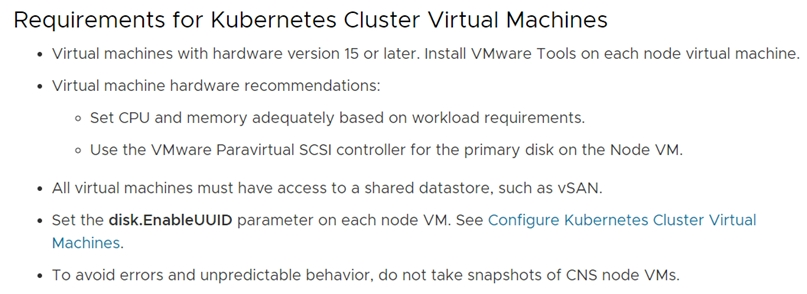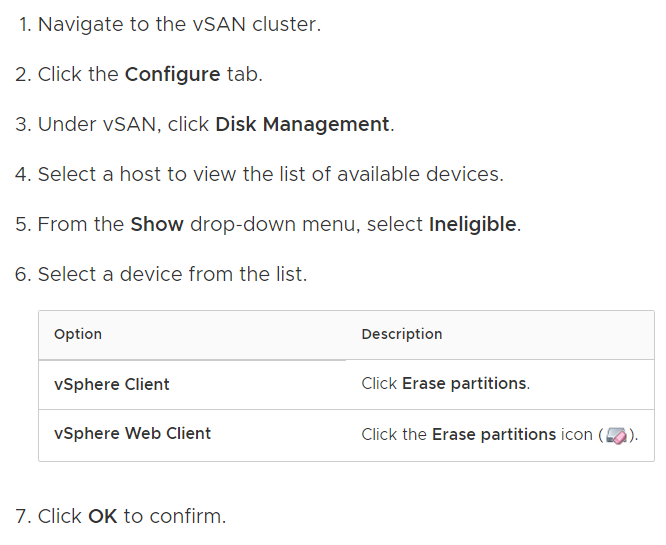A vSAN administrator, who has a cluster that has both compute-only and vSAN ReadyNodes, recently received a request to deploy a new application with higher storage performance requirements than what are currently available.
What are two ways the administrator can reconfigure the vSAN cluster to obtain this additional performance? (Choose two.)
BE
Reference:
https://docs.vmware.com/en/VMware-vSphere/7.0/vsan-703-planning-deployment-guide.pdf
An administrator is tasked with configuring vSAN Cloud Native Storage.
Which two requirements must be met for a successful configuration? (Choose two.)
BE
Reference:
https://docs.vmware.com/en/VMware-vSphere/6.7/Cloud-Native-Storage/GUID-BA795112-AFC4-4FCB-B5A6-1ACDCAB79ED3.html
When attempting to add a directly attached disk device to a host disk group, the intended disk does not show among the available devices in disk management.
Which action should be taken?
A
Reference:
https://docs.vmware.com/en/VMware-vSphere/6.7/com.vmware.vsphere.virtualsan.doc/GUID-90CCB01E-DE9C-47DA-9FEF-
8B3F107FEA2C.html#GUID-90CCB01E-DE9C-47DA-9FEF-8B3F107FEA2C
An administrator has discovered that space utilized by VMs does not decrease after deleting files and folders within the VMs. The administrator needs to be able to reclaim this space.
Which action could the administrator take to accomplish this task?
D
Reference:
https://blogs.vmware.com/virtualblocks/2018/09/10/vmware-vsan-6-7u1-storage-reclamation-trim-unmap/
The Resyncing Objects view in the vCenter UI reports that some objects are currently resyncing.
Which two actions would cause this situation? (Choose two.)
CD
Reference:
https://www.youtube.com/watch?v=1OYStxO1ges
A vSAN administrator has recently upgraded a vSAN cluster to 7.0 U1 and has enabled Capacity Reserve features to reduce the amount of capacity reserved for transient and rebuild operations.
Which scenario would prevent this feature from operating properly?
D
Reference:
https://blogs.vmware.com/virtualblocks/2020/09/24/effective-capacity-management-with-vsan-7-update-1/
A vSAN administrator notices the VMware Skyline Health: Network Latency Check reports indicate three hosts are non-compliant.
Which action should the vSAN administrator take?
B
An administrator is responsible for managing a 5-node vSAN 7.0 cluster that hosts 150 virtual machines. Each virtual machine belongs to one of the following vSAN Storage Policies: vSANPolicy1:
✑ Site Disaster Tolerance: None
✑ Failures to Tolerate: 1 failure - RAIN5 (Erase Coding)
vSANPolicy2:
✑ Site Disaster Tolerance: None
✑ Failures to Tolerate: No data redundancy
Following an unplanned power event within the datacenter, the administrator has been alerted to the fact that one host has permanently failed. Prior to the vSAN host failure, the usable storage capacity of the vSAN Cluster was more than 40%.
What will be the potential impact to any virtual machine that was running on the failed host using vSANPolicy2?
D
After a recent data loss event, the IT department plans to deploy a DR site using vSphere Replication with vSAN providing the storage backend.
The architect would like to know how many components will be created based on the following configuration:
✑ 2x 100 GB VMDK
✑ RAID 1 vSAN Storage Policy
✑ 4x Point in Time snapshots
How many components will be created?
B
Reference:
https://docs.vmware.com/en/vSphere-Replication/8.5/com.vmware.vsphere.replication-admin.doc/GUID-1FF815EB-80DC-401B-AD0E-
0898255DE624.html
In vSAN 7.0 U1, when a host enters into maintenance mode (EMM) using the `Ensure Accessibility` option, it will allow vSAN to write to another host in addition to the host holding the object replica.
What does vSAN write to that additional host?
A
Reference:
https://core.vmware.com/resource/vmware-vsan-design-guide